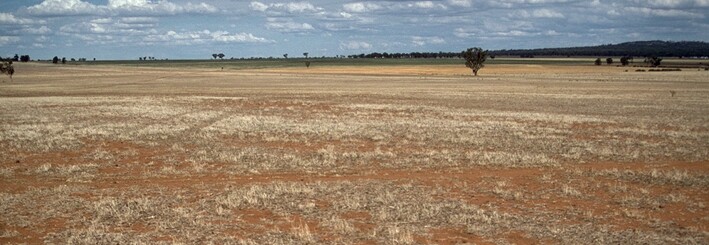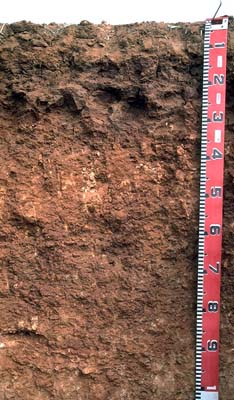LP46
| Group: Pyramid Hill Farm Advance | Australian Soil Classification: Calcic, Subnatric, Red SODOSOL |
| Northcote Factual Key:Dr 2.13 | Great Soil Group: red-brown earth |
| General Landscape Description: Midslope of a very gently undulating rise within the Granite Highland Landscape Unit. The original vegetation included Murray Pine (Callitris columellaris) and Yellow Box (Eucalyptus melliodora). | |
 LP46 Landscape |
Soil Profile Morphology
Surface Soil
| A1 | 0-8 cm | Dark reddish brown (5YR3/3); sandy clay loam; hardsetting surface condition; structureless; firm consistence dry; pH 6.3; abrupt change to: |  LP46 Profile |
| Subsoil | |||
| B1 | 8-10 cm | Dusky red (25YR3/4); light clay; structureless; very firm to strong consistence dry; pH 6.8; sharp change to: | |
| B21 | 10-35 cm | Dark red (2.5YR3/6); medium clay; strong coarse subangular blocky, parting to moderate fine polyhedral structure; strong consistence dry; pH 8.0; clear and wavy change to: | |
| B22 | 35-90 cm | Red (2.5YR4/6); medium clay; strong medium polyhedral structure; contains a few (2-10%) carbonates as well as granitic material; strong consistence dry; pH 9.0; clear and wavy change to: | |
| B/C | 90+ cm | Red (2.5YR4/8); clayey sand; structureless; strong consistence dry; pH 9.2; this horizon grades into weathered granite that also includes calcium carbonate. | |
| NOTE: This profile corresponds closely to the Terricks Sandy Clay Loam soil as described by Skene (1971). | |||
Key Profile Features
- Strong texture contrast between surface (A) horizon and clayey (B21) subsoil horizon.
- Hard-setting surface soil.
Key Profile Characteristics
pH | Salinity Rating | |||
Surface (A1 horizon) | slightly acid | very low | nearly sodic | moderate |
Subsoil (B21 horizon) | moderately alkaline | very low | sodic | complete |
Deeper subsoil (at 90 cm) | very strongly alkaline | low - medium | strongly sodic | strong |
 |
Horizon | Horizon Depth | pH (water) | pH CaCl2 | EC 1:5 | NaCl | Exchangeable Cations | |||
Ca | Mg | K | Na | ||||||
meq/100g | |||||||||
A1 | 0-8 | 6.3 | 0.13 | 5.1 | 2.1 | 1.5 | 0.4 | ||
B1 | 8-10 | 6.8 | 0.05 | 5 | 2.2 | 0.8 | 0.4 | ||
B21 | 10-35 | 8 | 0.12 | 9.5 | 6.3 | 1.7 | 2.8 | ||
B22 | 35-90 | 9 | 0.48 | 0.05 | 7.8 | 6.6 | 1.3 | 3.6 | |
B/C | 90+ | 9.2 | 0.75 | 0.09 | 5.1 | 7.4 | 2 | 6.7 | |
Horizon | Horizon Depth | Ex Al mg/kg | Ex Ac meq/100g | Field pF2.5 | Wilting Point pF4.2 | Coarse Sand (0.2-2.0mm) | Fine Sand (0.02-0.2mm) | Silt (0.002-0.02mm) | Clay (<0.002mm) |
A1 | 0-8 | 19.7 | 9.7 | ||||||
B1 | 8-10 | 16.1 | 9.1 | ||||||
B21 | 10-35 | 40.9 | 27.9 | ||||||
B22 | 35-90 | ||||||||
B/C | 90+ |
Management Considerations:
- In general, management strategies for all soils should aim to increase organic matter levels in the surface soil; minimise the degradation of soil aggregates and porosity; promote the development of stable biopores; improve the calcium status of the ion exchange complex (particularly when sodium is a significant part), and break up any hardpans. Less frequent tillage; using less aggressive implements, and working the soil at optimum moisture conditions can all assist in maintaining soil aggregation and porosity as well as reducing the breakdown of organic matter.
Surface (A) Horizon
- The surface soil slakes and displays moderate dispersion when wet. If the surface soil is exposed to disruptive forces (e.g. raindrop action, cultivation) when wet this may lead to the development of surface sealing which will restrict seedling emergence and water infiltration and result in increased water run-off. Dispersion will be exacerbated if the surface soil is worked whilst in a wet condition. Maintaining surface cover is important for soils such as these.
- The surface horizon has a relatively very low organic matter content and a low to moderate overall nutrient status. Building up organic matter levels is important for soils such as these.
- The surface horizon is hardsetting and moderately coherent, therefore it could restrict seedling emergence and may not be easy to work. Improving surface soil organic matter levels will assist in minimising structural problems such as surface sealing and hardsetting as well as improving soil fertility, water holding capacity and infiltration.
- The subsurface (B1) horizon disperses strongly after remoulding and may develop into a hardpan if excessively cultivated in a moist condition.
Subsoil (B) Horizons
- The upper subsoil is sodic and strongly dispersive – and likely to restrict root penetration and water movement into the subsoil. This may result in the surface soil above it becoming waterlogged after heavy rainfall. Lateral movement of water above the subsoil is likely to occur on sloping land.
- From 35 cm depth the soil becomes very strongly alkaline. This indicates that phosphorus and some trace elements such as iron, manganese, zinc and copper may be poorly available to plants and deficiencies may occur. Deficiencies can be determined by plant tissue analysis. Boron toxicity can also occur in strongly alkaline soils.
Landholder Comments:
- No gypsum has been added
- Oats (30 bags/acre)
- A four-year cropping cycle has just been completed.
Notes:
- Soil profile described by Mark Imhof, Paul Rampant and Karen de Plater (28/2/95)


